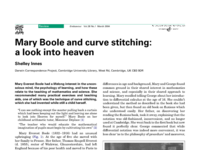A Look into Heaven
Mary Boole and curve stitching- a look into heaven
There is no precise record of when Mary invented curve stitching, but her own account suggests that she was still quite young. In her book, The Preparation of the Child for Science (1904), she described how the idea took shape:
In my young days cards of different shapes were sold in pairs, in fancy shops, for making needle-books and pin- cushions. The cards were intended to be painted on; and there was a row of holes round the edge by which twin cards were to be sewn together. As I could not paint, it got itself somehow suggested to me that I might decorate the cards by lacing silk threads across the blank spaces by means of the holes. When I was tired of so lacing that the threads crossed in the centre and covered the whole card, it occurred to me to vary the amusement by passing the thread from each hole to one not exactly opposite to it, thus leaving a space in the middle. I can feel now the delight with which I discovered that the little blank space so left in the middle of the card was bounded by a symmetrical curve made up of a tiny bit of each of my straight silk lines; that its shape depended upon, without being the same as, the outline of the card, and that I could modify it by altering the distance of the down-stitch from the up-stitch immediately preceding. were to be sewn together.
And why is this important...?
As the practical art of sewing perforated card was already quite familiar to me, my brain was free to receive as a seed the discovery I had made, and to let it grow naturally; all the more because no one spoke to me then of tangents, or tried to teach me any algebraic geometry, till some years had elapsed. Therefore, when I did begin to learn artificially about tangents, the teacher was not obliged to put cuttings into raw soil; he found ready a good strong wild stock of living interest in the relation between a curve and the straight lines which generate it, on to which he was able to graft the new knowledge. The teacher came, not as an outsider thrusting on me the knowledge of something unfamiliar and strange; but as a brother-seer more advanced than myself, who could show me how to make further progress on a path which I had already entered with delight.
